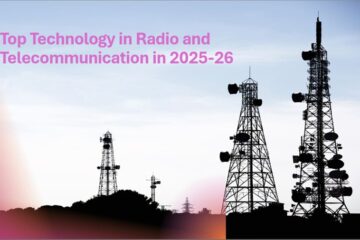The RF (Radio Frequency) and telecom industries are at the forefront of technological innovation, driving connectivity and communication across the globe. As we approach 2025, these industries are poised for significant transformation, driven by advancements in 5G, the Internet of Things (IoT), artificial intelligence (AI), and more. In this article, we will explore the future aspects of the RF and telecom industry in 2025, highlighting key trends, challenges, and opportunities shaping the sector.
Key Trends Shaping the RF & Telecom Industry
The 5G Revolution
By 2025, 5G technology is expected to be ubiquitous, revolutionizing how we connect and communicate. With its ultra-fast speeds, low latency, and ability to connect millions of devices, 5G will drive innovation across various sectors. It will enable smart cities, autonomous vehicles, and enhanced mobile broadband, opening up new possibilities for businesses and consumers alike.
Expansion of IoT
The Internet of Things (IoT) is set to grow exponentially by 2025, with billions of connected devices transforming industries such as healthcare, agriculture, and manufacturing. RF technology will play a crucial role in enabling seamless communication between these devices, allowing for real-time data exchange and analysis. This will lead to increased efficiency, improved decision-making, and new business models.
Integration of Artificial Intelligence
Artificial intelligence (AI) will become integral to the telecom industry by 2025, enhancing network management, customer service, and predictive maintenance. AI-powered algorithms will optimize network performance, reduce downtime, and personalize customer experiences. Additionally, AI-driven analytics will enable telecom companies to make data-driven decisions and offer innovative services.
Emergence of Smart Cities
Smart cities are expected to proliferate by 2025, driven by advancements in RF and telecom technologies. These cities will leverage 5G, IoT, and AI to optimize infrastructure, enhance public services, and improve the quality of life for residents. From smart traffic management to energy-efficient buildings, the telecom industry will play a pivotal role in creating sustainable urban environments.
Enhanced Cybersecurity Measures
As connectivity increases, so does the risk of cyber threats. By 2025, the RF and telecom industry will prioritize cybersecurity to protect sensitive data and maintain network integrity. Advanced encryption, AI-powered threat detection, and blockchain technology will be employed to safeguard networks and ensure the privacy of users.
Challenges Facing the RF & Telecom Industry
1. Infrastructure Development
The rollout of 5G and IoT requires significant infrastructure development, including the deployment of new base stations, fiber-optic networks, and edge computing facilities. Telecom companies must invest heavily in upgrading their infrastructure to meet the demands of future connectivity.
2. Spectrum Allocation
The availability of spectrum is critical for the success of 5G and IoT. Governments and regulatory bodies must allocate sufficient spectrum to telecom operators to ensure optimal network performance. Spectrum sharing and re-farming will also be essential to maximize resource utilization.
3. Regulatory Compliance
Navigating regulatory requirements will be a challenge for the RF and telecom industry in 2025. Companies must adhere to evolving regulations related to data privacy, spectrum usage, and environmental impact. Collaboration between industry stakeholders and policymakers will be crucial to create a conducive regulatory environment.
4. Workforce Skill Development
The rapid pace of technological advancement requires a skilled workforce capable of managing and operating complex networks. Telecom companies must invest in training and upskilling their employees to keep pace with industry developments and maintain a competitive edge.
Opportunities in the RF & Telecom Industry
1. Digital Transformation
The RF and telecom industry will drive digital transformation across various sectors by 2025. Businesses will leverage connectivity to streamline operations, enhance customer experiences, and develop innovative products and services. Telecom companies can capitalize on this trend by offering digital solutions tailored to industry-specific needs.
2. Rural Connectivity
Bridging the digital divide in rural areas presents a significant opportunity for the telecom industry. By expanding network coverage and providing affordable services, telecom companies can tap into underserved markets and improve the quality of life for rural communities.
3. Green Telecom Initiatives
Sustainability will be a key focus for the RF and telecom industry in 2025. Companies can reduce their environmental impact by adopting energy-efficient technologies, optimizing network operations, and promoting green practices. This will not only benefit the environment but also enhance brand reputation and attract environmentally conscious consumers.
4. Collaboration and Partnerships
Collaboration between telecom companies, technology providers, and industry stakeholders will be essential to drive innovation and overcome challenges. By forming strategic partnerships, companies can share resources, knowledge, and expertise to accelerate the development of new technologies and services.
Conclusion
As we look towards 2025, the RF and telecom industry is set to undergo significant transformation, driven by advancements in 5G, IoT, and AI. While challenges such as infrastructure development and regulatory compliance remain, the industry is poised for growth, offering numerous opportunities for innovation and digital transformation. By embracing these trends and overcoming challenges, the RF and telecom industry will play a crucial role in shaping the connected world of the future.
FAQ’s
Q1: What is the role of 5G in the future of the telecom industry?
A1: By 2025, 5G will be the backbone of the telecom industry, enabling high-speed connectivity, low latency, and massive device connectivity. It will drive innovation across sectors such as healthcare, transportation, and entertainment, offering new business opportunities and enhanced user experiences.
Q2: How will IoT impact the telecom industry in 2025?
A2: IoT will transform the telecom industry by connecting billions of devices and generating vast amounts of data. Telecom companies will play a crucial role in providing the infrastructure and connectivity needed for IoT applications, leading to increased efficiency, automation, and new revenue streams.
Q3: What challenges will the RF and telecom industry face in 2025?
A3: Key challenges include infrastructure development, spectrum allocation, regulatory compliance, and workforce skill development. Companies must invest in upgrading networks, navigating regulatory requirements, and training employees to stay competitive in the evolving landscape.
Q4: How can telecom companies capitalize on digital transformation?
A4: Telecom companies can offer digital solutions tailored to specific industries, enabling businesses to optimize operations, enhance customer experiences, and develop innovative products and services. By leveraging connectivity and data analytics, companies can drive digital transformation and unlock new revenue streams.
Q5: What role will cybersecurity play in the future of the telecom industry?
A5: Cybersecurity will be a top priority for the telecom industry in 2025, with advanced measures such as AI-powered threat detection and blockchain technology employed to protect networks and user data. Ensuring robust security will be essential to maintain trust and safeguard against cyber threats.



0 Comments